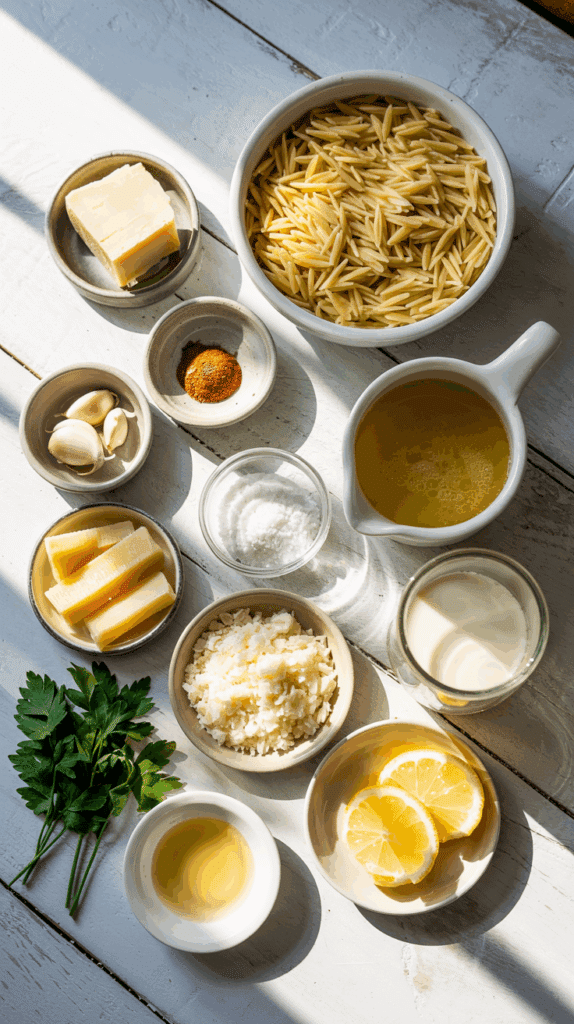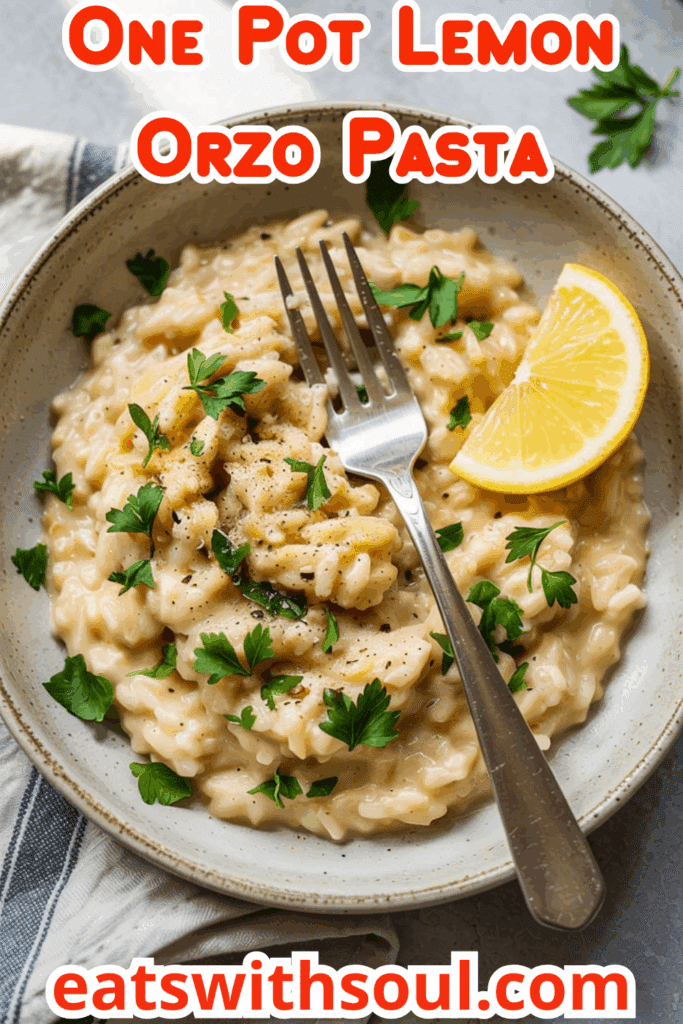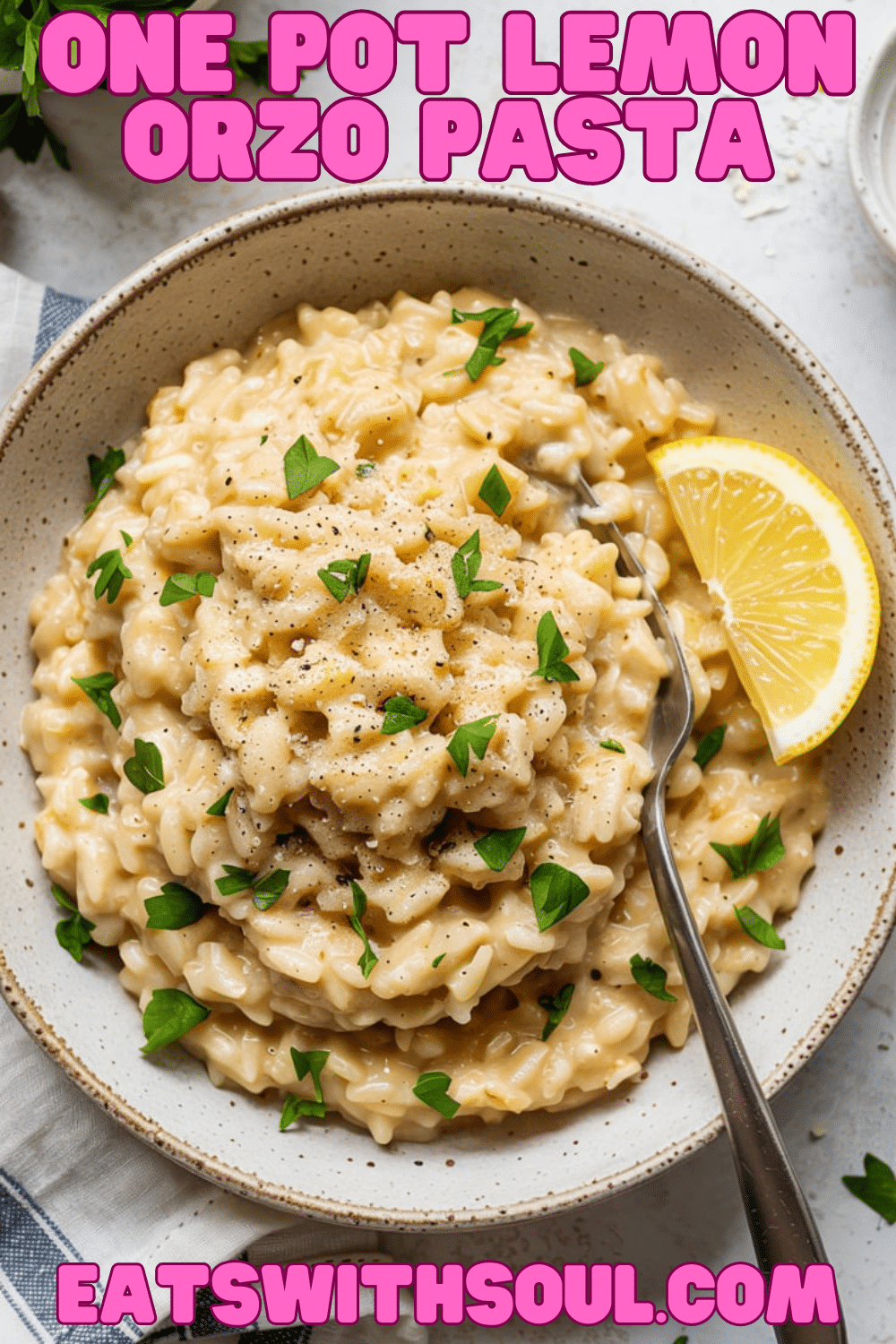Introduction & Inspiration
Let me share a recipe that has become an absolute lifesaver in my kitchen for quick, comforting, yet elegant meals: this Creamy One-Pot Lemon Orzo Pasta! It’s amazing how simple ingredients and one pot can yield such a delicious result. Imagine tiny orzo pasta, toasted slightly in butter and garlic, then simmered gently in savory broth until perfectly tender and creamy, finally finished with Parmesan cheese, a touch of cream, fresh parsley, and bright lemon juice.
My inspiration for this dish comes from the technique used in risotto, where the starch from the grain creates its own creamy sauce, but applied to pasta for a quicker result, all in one pan! I wanted a dish that was bright, satisfying, and required minimal cleanup – perfect after a long day.
This One-Pot Lemon Orzo is fantastic as a simple vegetarian main course, a sophisticated side dish for chicken or fish, or even just a comforting bowl all on its own. It’s incredibly flavorful and comes together so easily! It is a perfect recipe for a quick dinner.
Nostalgic Appeal / Comfort Factor
Creamy pasta dishes are the ultimate comfort food for so many. The combination of tender pasta, savory broth, salty cheese, and rich cream hits all the right satisfying notes. Lemon adds a bright, clean flavor that feels both refreshing and classically appealing, often found in comforting Italian-American dishes.
This recipe delivers that comforting creaminess and familiar lemon-Parmesan flavor profile in an incredibly simple format. The one-pot method adds its own layer of ease and comfort – less stress, less mess, more deliciousness.
It’s a dish that feels both nourishingly simple and luxuriously creamy, perfect for a cozy meal. A perfect comfort food dish.
Homemade Focus (One-Pot Technique)
This recipe beautifully highlights the magic of homemade, one-pot cooking. You’re taking simple pantry staples like orzo and broth, combining them with fresh garlic, lemon, parsley, and quality cheese, and transforming them into a cohesive, flavorful dish using a specific technique.
The “homemade” aspect shines in building the flavor base by toasting the orzo and garlic in butter, cooking the pasta directly in the broth to absorb flavor and create natural creaminess from its starches, and finishing the sauce yourself with fresh Parmesan, cream, and lemon juice.
It celebrates how a simple homemade method can yield results that taste far more complex than the effort involved, creating a restaurant-quality side or main dish with ease. The homemade taste is incredible.
Flavor Goal
The primary flavor goal is a bright, savory, and creamy pasta dish where tangy lemon and salty Parmesan are the stars, supported by aromatic garlic and fresh parsley, all coating perfectly cooked orzo.
The orzo should be tender with a slight al dente chew, suspended in a naturally creamy sauce derived from the pasta starch, broth reduction, cream, and melted Parmesan. The garlic should be fragrant but not overpowering, and the lemon juice, added at the end, needs to provide a clear, bright acidity that cuts through the richness.
The overall experience should be creamy, comforting, bright, savory, cheesy, and herbaceous – a perfectly balanced and satisfying pasta dish. A perfect balance between flavour and texture.
Ingredient Insights
- Salted Butter: Used to toast the orzo and sauté the garlic, providing richness and flavor foundation. Unsalted butter can be used; adjust salt later.
- Orzo Pasta (Uncooked): Small, rice-shaped pasta. Toasting it briefly in butter enhances its nutty flavor. It releases starch as it cooks in the broth, contributing to the sauce’s creaminess. (Approx. 278 grams).
- Garlic (Finely Minced): Essential aromatic flavor, lightly toasted with the orzo.
- Low Sodium Vegetable or Chicken Broth: The primary cooking liquid, infusing the orzo with flavor. Low sodium allows better control over final saltiness, crucial as Parmesan is salty.
- Salt & Fresh Cracked Black Pepper: Essential seasonings. Add salt carefully, tasting at the end. Freshly cracked pepper adds noticeable flavor.
- Cream (Any Kind): Adds richness and final creamy texture. Heavy cream gives the richest result; light cream or half-and-half makes it lighter; even whole milk can work for a much lighter sauce.
- Grated Parmesan Cheese: Provides salty, nutty, umami flavor and significantly boosts the sauce’s creaminess and body. Use freshly grated Parmesan for best melting and flavor.
- Fresh Parsley (Chopped): Adds fresh, herbaceous flavor and color stirred in at the end.
- Fresh Lemon Juice: Crucial for brightness and cutting through richness. Added gradually at the end to taste, as lemon intensity varies.
Essential Equipment
- Large Skillet or Pot with Lid: Needs to be wide enough to toast orzo but deep enough to hold broth, and must have a lid for simmering. A high-sided skillet or a medium pot/Dutch oven works well.
- Measuring Cups & Spoons:
- Knife & Cutting Board: For mincing garlic, chopping parsley, juicing lemon.
- Grater (Microplane or Box): For grating fresh Parmesan cheese.
- Whisk or Spoon/Spatula: For stirring.
Ingredients
(US Customary first, Metric/Grams in parentheses where provided)
- ▢ 1 tablespoon salted butter
- ▢ 1½ cups uncooked orzo pasta (about 278 grams)
- ▢ 2 cloves garlic, finely minced
- ▢ 2½ cups low sodium vegetable or chicken broth
- ▢ ½ teaspoon salt (adjust to taste, considering broth/butter/Parmesan)
- ▢ ¼ teaspoon fresh cracked black pepper
- ▢ ⅓ cup cream (heavy, light, or half-and-half)
- ▢ 2 tablespoons grated Parmesan cheese (plus more for serving)
- ▢ 2 tablespoons fresh parsley, chopped
- ▢ Juice of 1 lemon (about 2-3 tablespoons, add gradually)

Step-by-Step Instructions
1. Toast Orzo and Garlic:
- Melt the salted butter in a large skillet or pot over medium-high heat.
- Add the uncooked orzo pasta and the finely minced garlic to the melted butter.
- Cook, stirring frequently, for 1-2 minutes until the orzo is lightly toasted (it may become slightly golden and smell nutty) and the garlic is fragrant. Be careful not to burn the garlic.
2. Add Broth and Seasonings:
- Carefully pour in the low-sodium vegetable or chicken broth.
- Stir in the salt and fresh cracked black pepper.
3. Simmer Orzo:
- Bring the mixture to a boil.
- Once boiling, immediately reduce the heat to medium-low to maintain a gentle simmer.
- Cover the skillet or pot with a lid and let it simmer, stirring often (especially towards the end) to prevent sticking.
- Cook until most of the liquid is absorbed and the orzo pasta is cooked to your preference (tender but ideally still slightly al dente), which takes about 10 minutes. (If the liquid absorbs before pasta is cooked, add a splash more hot broth or water and continue simmering briefly).
4. Finish with Cream, Cheese, and Herbs:
- Once the orzo is cooked and most liquid absorbed, stir in the cream (heavy, light, or half-and-half) and the grated Parmesan cheese.
- Stir continuously over low heat until the cheese is melted and the sauce is creamy.
- Stir in the chopped fresh parsley.
5. Add Lemon Juice and Serve:
- Remove the pot from the heat.
- Add the fresh lemon juice gradually, starting with about half (1-1.5 tablespoons). Stir and taste. Add more lemon juice until the flavor is bright and balanced to your preference.
- Serve the Creamy One-Pot Lemon Orzo immediately, garnished with extra grated Parmesan cheese and a sprinkle more fresh parsley if desired.

Troubleshooting
- Orzo Sticky/Clumpy: Not stirred enough during simmering, or overcooked. Stirring occasionally, especially as liquid reduces, is important. Cook just until al dente.
- Orzo Undercooked/Hard: Needs more liquid or more simmering time. Add hot broth/water by the splash if liquid absorbed too quickly. Ensure lid was tight.
- Sauce Too Thick: Orzo absorbed all liquid. Stir in a splash of warm broth, cream, or milk off heat until desired consistency.
- Sauce Too Thin: Started with slightly too much liquid, or didn’t simmer long enough uncovered (though recipe keeps covered mostly). Simmer gently uncovered for a minute or two before adding cheese/cream if orzo is cooked but liquid remains excessive. Parmesan and cream will thicken it somewhat.
- Bland Flavor: Needs more salt! Also ensure enough garlic, fresh lemon juice (added to taste!), and quality Parmesan were used. Toasting orzo adds depth.
- Too Lemony: Added too much lemon juice at once. Add gradually and taste frequently. Stirring in a touch more cream or Parmesan might help balance slightly.
Tips and Variations
- Toasting Orzo: Don’t skip this! It adds a lovely nutty dimension to the pasta.
- Stir Often: Especially as the liquid reduces, stir frequently to prevent sticking and help release starch for creaminess.
- Fresh Lemon Juice: Essential for bright flavor. Add it off heat at the very end to preserve its freshness, and add to taste.
- Parmesan Quality: Use freshly grated Parmesan Reggiano for the best flavor and smooth melt.
- Add Veggies: Stir in frozen peas or chopped fresh spinach during the last 2-3 minutes of cooking to wilt/heat through. Sautéed mushrooms or steamed asparagus could be added with the cream/Parmesan.
- Add Protein: Serve topped with grilled chicken (like the previous Lemon Herb chicken!), shrimp, or seared scallops. Stir in cooked shredded chicken or canned chickpeas at the end.
- Herbs: Fresh dill or basil could substitute for or be added with parsley.
- White Wine: Deglaze the pan with a splash of dry white wine after toasting the garlic/orzo, before adding the broth, for extra flavor.
Serving and Pairing Suggestions
- Serve Hot: Best enjoyed immediately while creamy and warm.
- Main Course: A satisfying vegetarian main dish.
- Side Dish: Excellent alongside grilled fish, chicken, shrimp, or roasted vegetables.
- Garnish: Extra Parmesan, fresh parsley, black pepper, and maybe a lemon wedge.
Nutritional Information
(Note: Estimated, per serving, assuming 4 servings. Variable based on cream fat %, Parmesan amount, broth sodium.)
- Calories: 400-550
- Fat: 18-30g
- Saturated Fat: 8-15g
- Cholesterol: 40-70mg
- Sodium: 600-900mg+ (Depends heavily on broth, butter, Parmesan, added salt)
- Total Carbohydrates: 50-60g
- Dietary Fiber: 2-4g
- Sugars: 3-6g
- Protein: 12-18g
Creamy One-Pot Lemon Orzo Pasta
Make this incredibly easy and Creamy One-Pot Lemon Orzo Pasta! Features orzo cooked risotto-style in broth with garlic, finished with Parmesan, cream, lemon, and parsley.
Ingredients
(US Customary first, Metric/Grams in parentheses where provided)
- ▢ 1 tablespoon salted butter
- ▢ 1½ cups uncooked orzo pasta (about 278 grams)
- ▢ 2 cloves garlic, finely minced
- ▢ 2½ cups low sodium vegetable or chicken broth
- ▢ ½ teaspoon salt (adjust to taste, considering broth/butter/Parmesan)
- ▢ ¼ teaspoon fresh cracked black pepper
- ▢ ⅓ cup cream (heavy, light, or half-and-half)
- ▢ 2 tablespoons grated Parmesan cheese (plus more for serving)
- ▢ 2 tablespoons fresh parsley, chopped
- ▢ Juice of 1 lemon (about 2-3 tablespoons, add gradually)
Instructions
1. Toast Orzo and Garlic:
- Melt the salted butter in a large skillet or pot over medium-high heat.
- Add the uncooked orzo pasta and the finely minced garlic to the melted butter.
- Cook, stirring frequently, for 1-2 minutes until the orzo is lightly toasted (it may become slightly golden and smell nutty) and the garlic is fragrant. Be careful not to burn the garlic.
2. Add Broth and Seasonings:
- Carefully pour in the low-sodium vegetable or chicken broth.
- Stir in the salt and fresh cracked black pepper.
3. Simmer Orzo:
- Bring the mixture to a boil.
- Once boiling, immediately reduce the heat to medium-low to maintain a gentle simmer.
- Cover the skillet or pot with a lid and let it simmer, stirring often (especially towards the end) to prevent sticking.
- Cook until most of the liquid is absorbed and the orzo pasta is cooked to your preference (tender but ideally still slightly al dente), which takes about 10 minutes. (If the liquid absorbs before pasta is cooked, add a splash more hot broth or water and continue simmering briefly).
4. Finish with Cream, Cheese, and Herbs:
- Once the orzo is cooked and most liquid absorbed, stir in the cream (heavy, light, or half-and-half) and the grated Parmesan cheese.
- Stir continuously over low heat until the cheese is melted and the sauce is creamy.
- Stir in the chopped fresh parsley.
5. Add Lemon Juice and Serve:
- Remove the pot from the heat.
- Add the fresh lemon juice gradually, starting with about half (1-1.5 tablespoons). Stir and taste. Add more lemon juice until the flavor is bright and balanced to your preference.
- Serve the Creamy One-Pot Lemon Orzo immediately, garnished with extra grated Parmesan cheese and a sprinkle more fresh parsley if desired.
Recipe Summary and Q&A
Summary: This Creamy One-Pot Lemon Orzo Pasta involves toasting uncooked orzo and garlic in butter in a large skillet or pot. Broth and seasonings are added, and the mixture is simmered covered, stirring often, until the orzo is al dente and the liquid is mostly absorbed. Cream, grated Parmesan cheese, and fresh parsley are stirred in off heat, followed by fresh lemon juice added gradually to taste. It’s served hot.
Q&A:
- Q: Why cook the orzo directly in the broth (risotto-style)?
- A: This method allows the orzo to release its natural starches directly into the cooking liquid, creating a naturally creamy sauce without needing excessive amounts of cream or cheese. It also infuses the pasta itself with the flavor of the broth and aromatics.
- Q: Can I use regular long-grain rice instead of orzo?
- A: No, this method is specific to pasta like orzo. Regular rice requires different liquid ratios and cooking times/methods.
- Q: Can I make this ahead of time?
- A: Like risotto, this dish is truly best served immediately after cooking for the optimal creamy texture. Leftovers will thicken considerably as the orzo continues to absorb liquid upon cooling. Reheat gently on the stovetop or microwave, adding a splash of broth or milk to loosen it up again, but the texture won’t be quite the same as fresh.
- Q: What kind of cream works best?
- A: Heavy cream will give the richest, most luxurious result. Light cream or half-and-half will create a lighter sauce. Even whole milk can work if you want it very light, but the creaminess will be much less pronounced.

